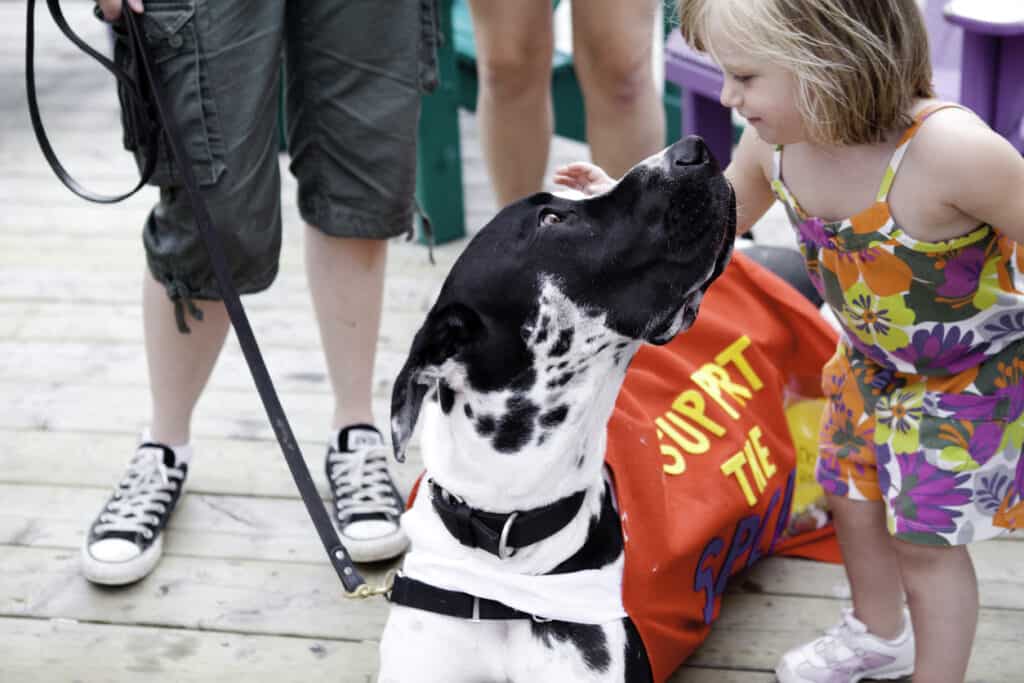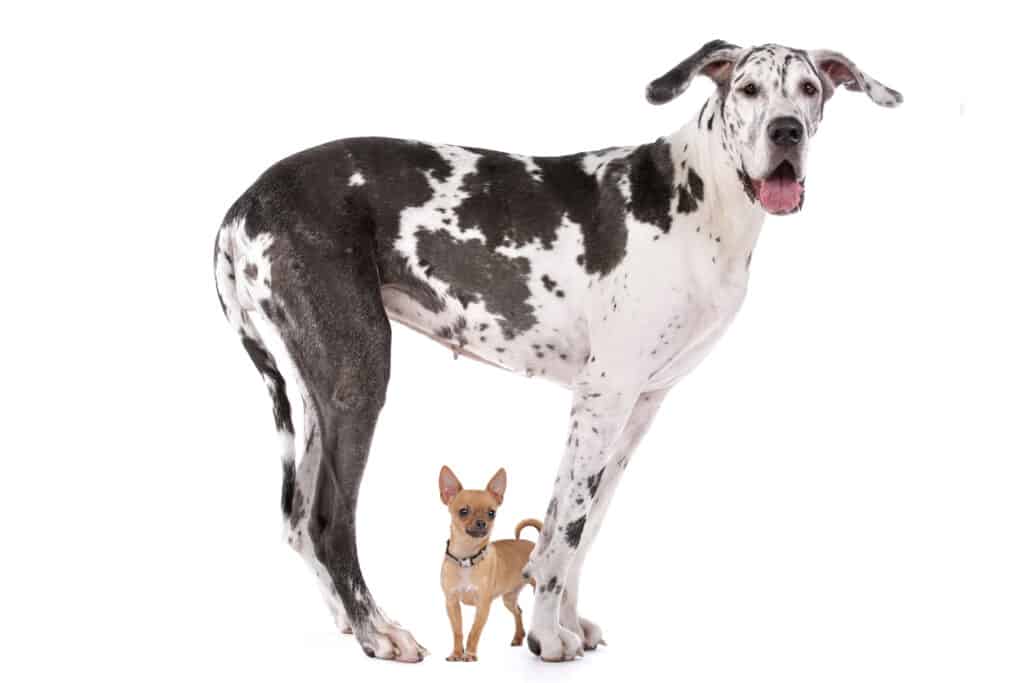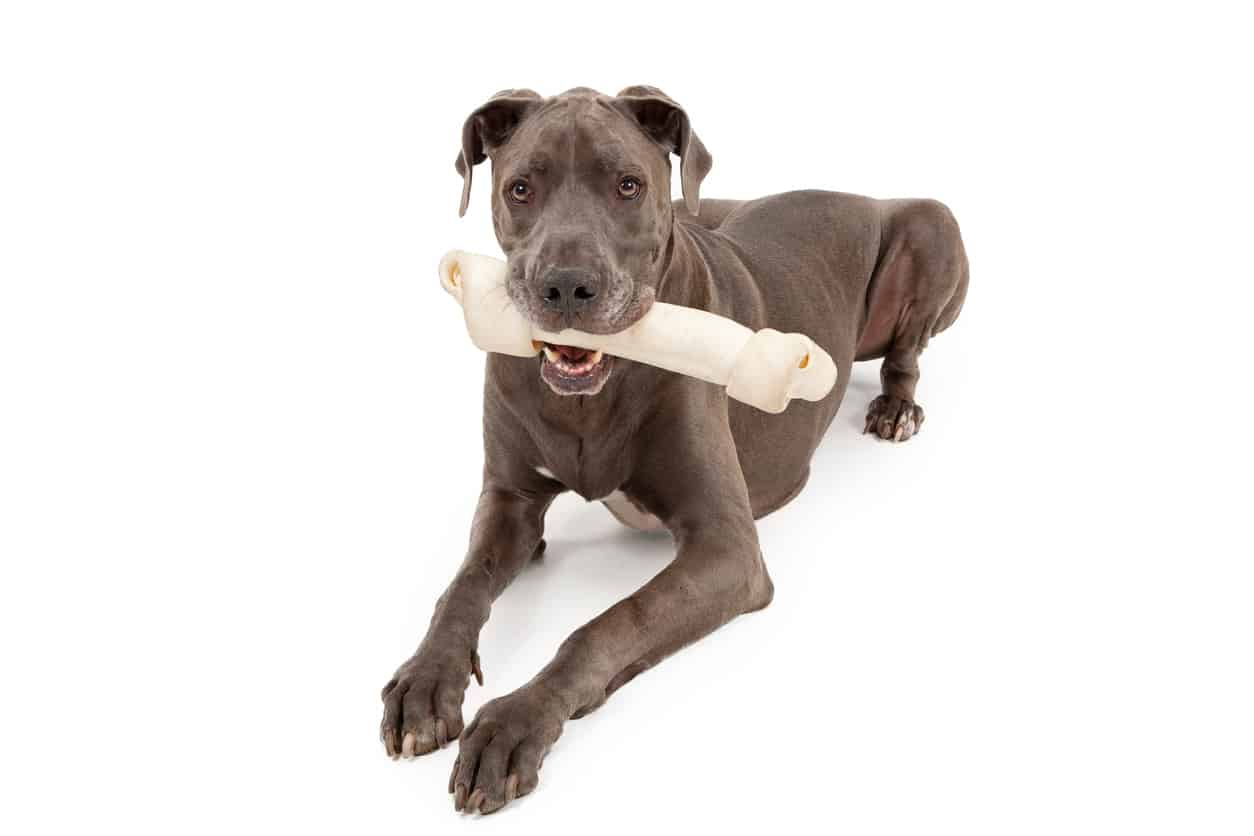Great Danes are enormous, noble-looking dogs that are known as the “Apollo of Dogs.” Unlike the Greek god, however, the Great Dane lifespan is quite short compared to that of many other breeds.

On average, Great Danes live for just 8-12 years. Although there are a variety of factors that play into their longevity, prospective owners should be aware of their short lifespan so as to be able to make an informed decision regarding whether a Great Dane is the right breed for them.
Two principal factors that affect the Great Dane lifespan are its genetics and the nutrition it receives as a puppy. While many people will be familiar with the importance of performing due diligence on the breeder or organization from which they are considering buying or adopting a Great Dane, the outsize affect good (or poor) nutrition can have on a Great Dane puppy over the course of its life is an evolving field of knowledge in the niche world of Great Danes.
Prospective owners seeking to buy a purebred Great Dane puppy should be aware that the breed is prone to a host of issues because of its genetics. Bred for size and strength, the Great Dane is also a lean animal that requires solid body proportions in order to support and grow the body for which it was bred to have. While puppies will weigh between 1-2 pounds at birth, fully grown, male Great Danes stand between 30-32 inches at the shoulder while females are expected to be between 28-30 inches. Often, both males and females exceed those expected ranges.
Prospective owners should be aware that the amount of growing that occurs from the moment a Great Dane is born until it reaches its full height and size is simply so much more than most other breeds that regulating the speed at which a puppy grows plays a critical role in determining how long it lives.
The reason for this regulation is that Great Dane puppies grow for so much longer than many other breeds. As a massive dog breed, it takes them around three years to reach their full adult size and proportions. Due to this extended growth stage, Great Danes also enjoy extended puppyhoods. Within the first three years of a Great Dane’s life, the first year is crucial due to the fact that a Great Dane will, on average, put on 100 pounds by the time it reaches its first birthday. Thus, regulating the speed at which that growth happens means that owners can be mindful of the still-developing skeletal structure of their puppy. Being mindful will require owners to learn about the proper proportion of nutrients required specifically for Great Dane puppies to grow correctly, which will require a certain level of fluency in reading puppy and dog food labels. The more aware, the less likely your puppy will be to develop common afflictions of the breed, such as hip and elbow dysplasia, or wobbler syndrome.
Great Dane Health Problems at Ages

Hip and elbow dysplasia are essentially deformities that occur at the hip or elbow joint. Large dog breeds are particularly susceptible to these issues due to their huge size, which is why it’s important for Great Dane owners to be proactive about monitoring the speed at which their Great Dane puppy grows. A properly developed Great Dane puppy will require a special diet rich in calcium, phosphorous, and protein, with meals spaced out at small intervals throughout the day. Educating oneself on the importance of making and following a balanced diet for a Great Dane puppy is one of the best ways that owners can set their puppies up for long, healthy lives.
Wobbler syndrome is a serious neck vertebral disease that causes Great Danes to have a curious gait. Due to the compression in the neck caused by the syndrome, Danes suffering from Wobbler syndrome will take short, floaty steps with their front limbs and have a wobbly (hence the name of the syndrome) gait in the hind limbs. While Great Danes can be afflicted with Wobbler syndrome at any age, emerging research is beginning to show that young Danes may be afflicted with the syndrome as a result of growing too quickly as puppies, which places an additional emphasis on the importance for breeders and owners to educate themselves on how to properly feed and care for a Great Dane puppy in order to raise a healthy Great Dane dog.
Unfortunately, some conditions are often left to chance, and in the case of the Great Dane, one of the many maladies that dogs the breed is that of cardiomyopathy. Cardiomyopathy is a life-threatening heart disease that affects Great Danes when the heart becomes enlarged and one chamber is more affected than the other.
How to help your Great Dane live longer

Another way that owners can provide a strong base for later longevity for their Great Danes is by providing suitable forms of exercise for their puppies that reflect the unique exercise needs of the breed. Great Danes take around three years to reach full maturity, meaning that their exercise needs to be carefully monitored so that they don’t stress their still-developing joints. Particularly during that first year, owners should schedule several shorter sessions of play spaced out well throughout the day, and never immediately following a meal. The first eighteen months of a Great Dane’s life are considered critical for its skeletal development. Because Great Danes become such large animals, slow and steady growth should be prioritized over rapid growth and weight gain. Although Great Danes are characterized as mellow and calm dogs, they can still be quite high energy as puppies, and a Great Dane puppy will require around 60 minutes of playtime total throughout the day.
Once your Great Dane puppy is fully grown, it will not need as much exercise as it once did, but it will still require regular, soft impact exercise throughout the day. It’s important to note that despite its size, Great Danes are not well-suited for vigorous endurance activities such as long runs or extensive hikes. The reason for this comes back to the topic of their joints: their limbs are simply too long to be able to maintain a vigorous pace (or to execute complicated maneuvers such as scrambling up and over rocks to navigate uneven terrain) without risking physical injury. Thus, Great Danes are an excellent choice of breed for people who are regularly at home to provide the affectionate Dane companionship in the home and company on regular short walks.
Adult Great Danes are loving and devoted family members. If owners have taken the responsible step of learning how to properly nourish a Great Dane puppy so that it becomes a healthy adult, one of the key risks to the animal’s overall health will have been mitigated. As adults, Great Danes require a different sort of supervision with regard to their diet and exercise. Great Danes, like many large breeds, are prone to a condition commonly known as bloat, and officially called Gastric Dilation Volvulus. Bloat occurs when a dog’s stomach fills with gas, food, or fluid, and unexpectedly twists, resulting in stomach distention and extreme pain for the animal and the need for immediate veterinary assistance.
Bloat at older ages
Bloat can be a life-threatening condition because the twisted stomach completely prevents blood from being carried to major organs, which then impacts blood flow throughout the body, which causes the animal’s body to go into shock. Immediate veterinary assistance is needed to assist a Great Dane suffering from bloat because the effect can be long term internal damage or even death.
Another reason bloat is such a threat to Great Danes is because it can be caused from a wide variety of natural and seemingly harmless activities. For example, a Great Dane may develop bloat as a result of eating too quickly, eating too much, ingesting too much water too quickly, stress, or exercising too soon after eating. Age and genetic factors also play a role, but it’s important to note that bloat is not a risk exclusive to Great Danes. Large breed dogs with deep chests are especially prone to the condition.
Genetics play a huge role in the longevity of any animal, but particularly one such as the Great Dane, which comes from a historic line of carefully selected breeding, which today manifests as a mix between English Mastiffs and Irish Wolfhounds. Originally bred to chase down wild boar in the forests of Germany, they were also naturally suited to defending their masters. As their popularity for doing so increased, breeders began to introduce other breeds of dog into the Great Dane bloodline. Today, there are two types of Great Danes – the American Great Dane and the European Great Dane. There are only slight differences between the two, but one of these differences could influence a prospective owner’s decision with regard to purchasing a purebred Great Dane puppy.
American Great Danes are typically just slightly slimmer in overall build, while the European Great Dane is just slightly stockier in build and face shape. Additionally, the European Great Dane tends to have more lip on it, meaning that there is more skin around the face, which could make it slightly more susceptible to skin issues. Dogs with floppier lips will also drool more. On the other hand, the American Great Dane is slightly sleeker in its overall look, making it perhaps slightly more susceptible to allergies or skin irritation (bear in mind, both types are susceptible to skin issues on their body and face).
Ultimately, prospective owners of Great Dane have many resources from which they can learn about how to properly raise a Great Dane puppy. Although genetics play a huge role in the health of a Great Dane, this risk can be mitigated by ensuring open and clear communication occurs with the breeder.
Breeders should be knowledgeable about the many health challenges Great Danes face at a baseline, as well as be able to advise regarding caring for and raising a Great Dane puppy. They should exercise responsible breeding practices, such as abstaining from breeding certain color pairs of Great Danes due to the increased risk of producing unhealthy puppies or abstaining from breeding Great Danes with cherry eye, a mostly-benign but extremely unsightly eye condition requiring veterinary attention. They should also be able to provide thoughtful and honest answers with regard to whether or not an interested party would make a suitable owner of a Great Dane.
Despite their short lifespan and the host of potential health issues that dog Great Danes, their affectionate and dedicated nature makes it easy to fall in love with them as pets. Fortunately, there are also many steps that a prospective Great Dane owner can take to ensure that they are able to provide the best possible care for their Great Dane, and in so doing, ensure that they live the longest life possible given their genetics and size.

